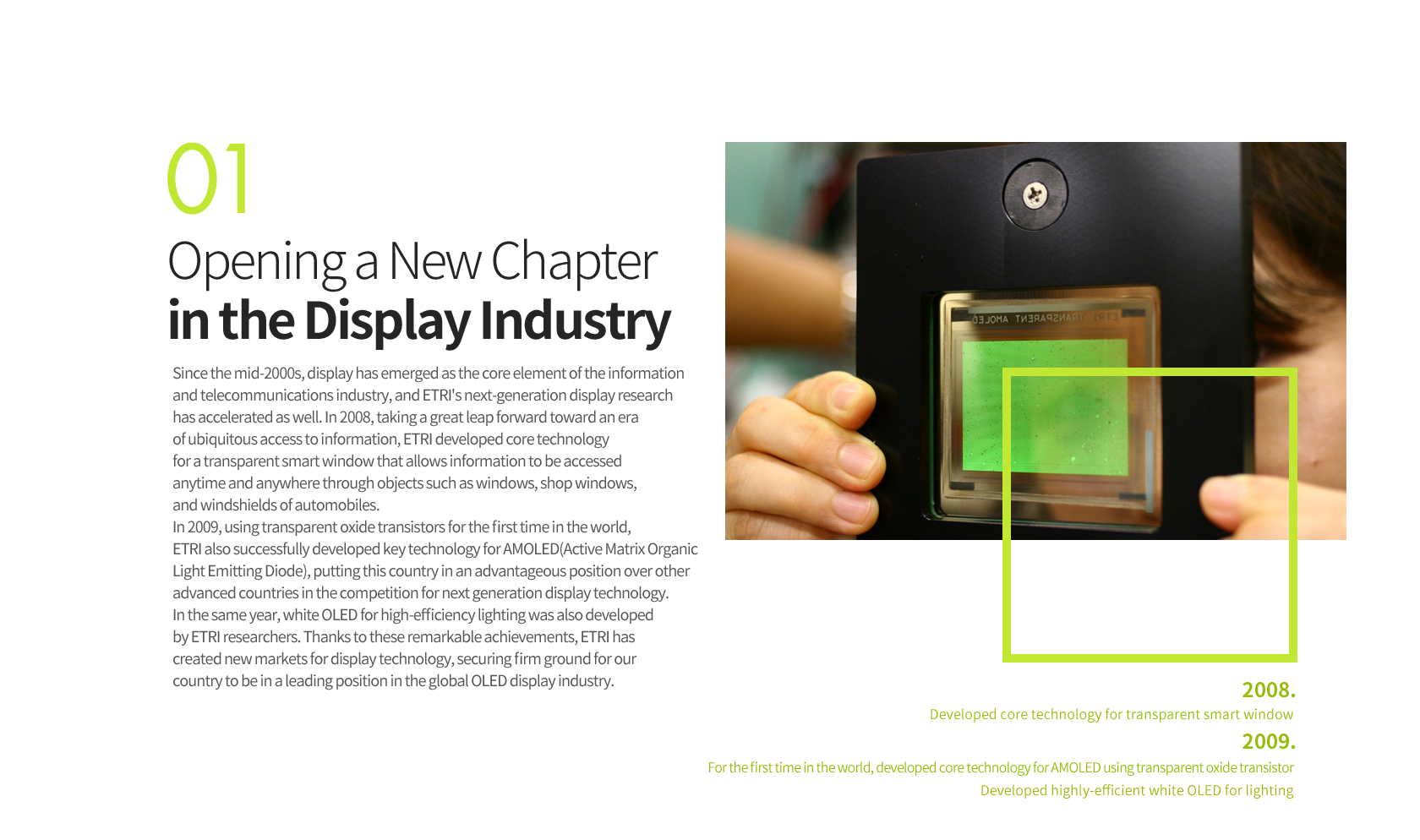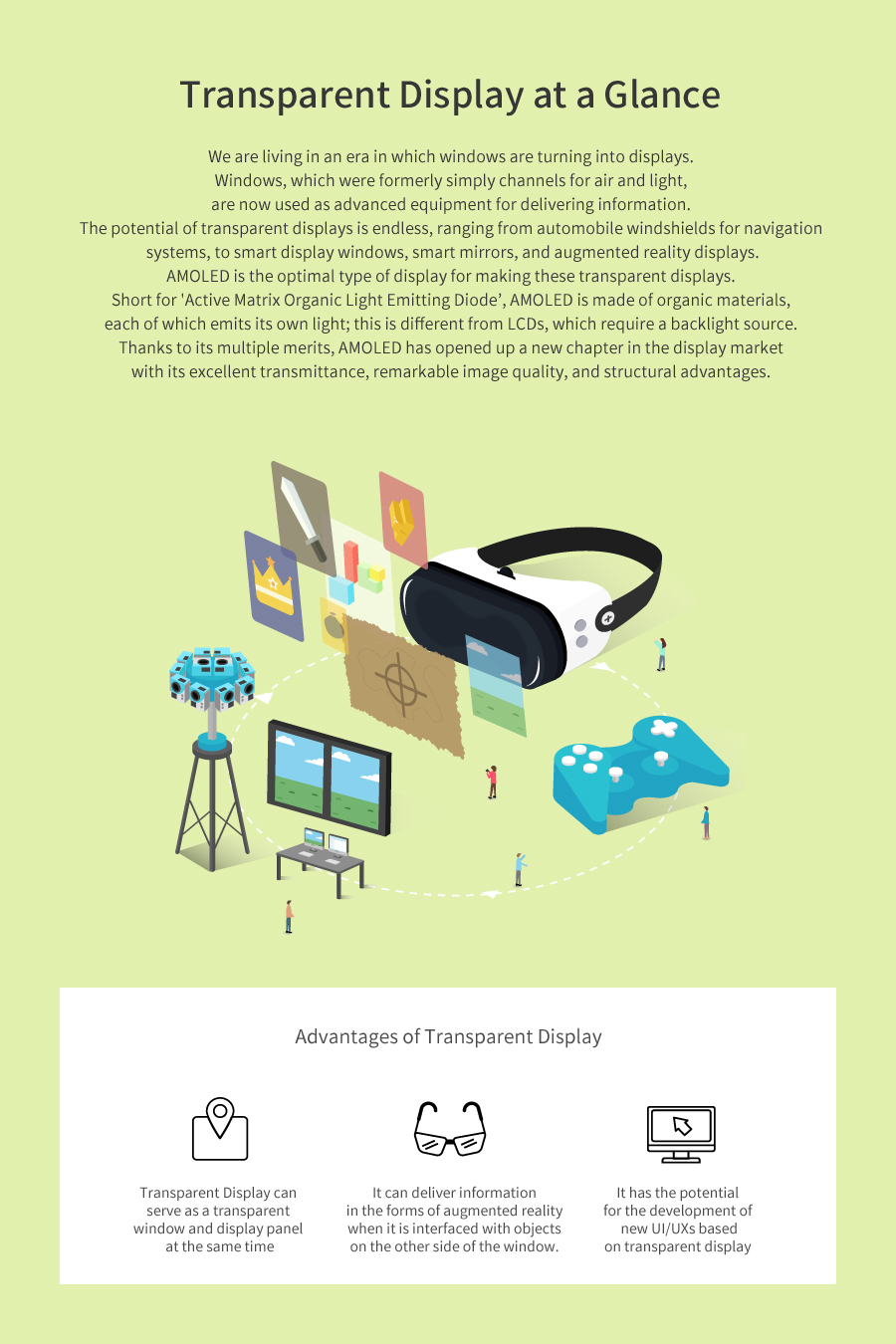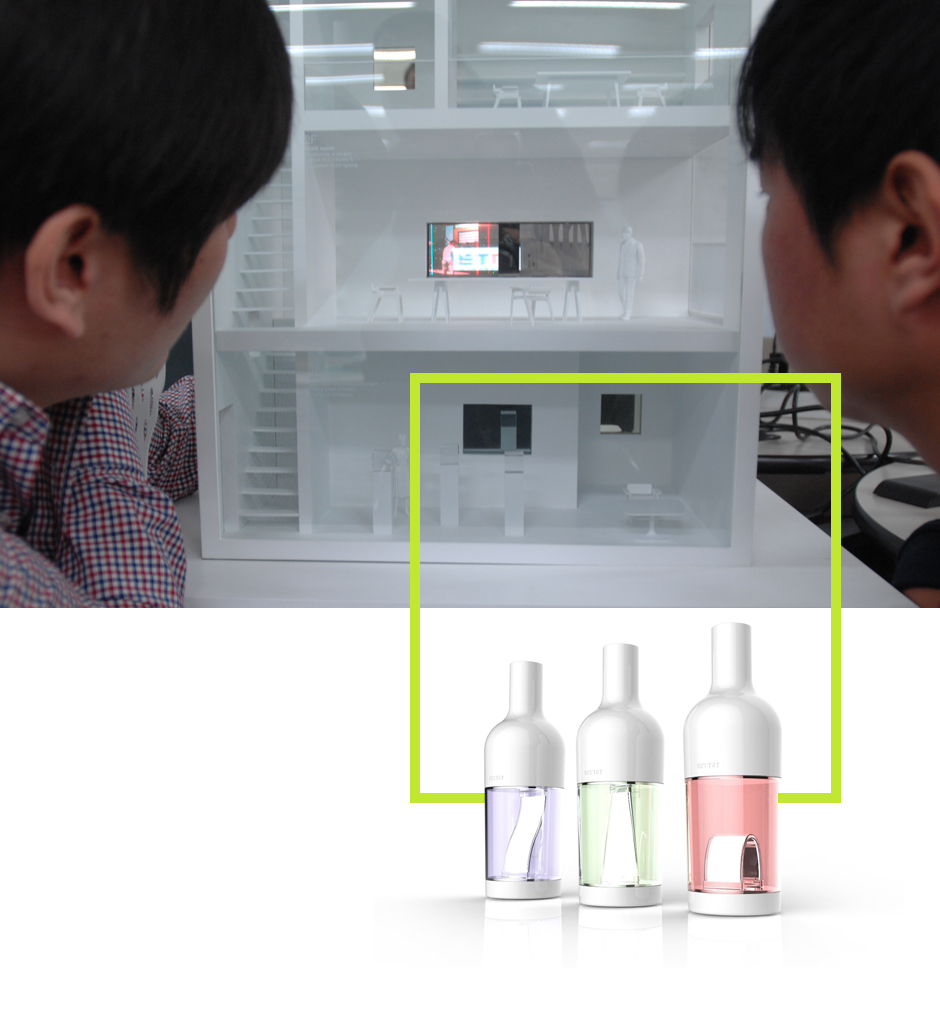




Looking Into
Our Future through
Transparent Display
Transparent Display
ETRI has developed a key source technology that can dramatically improve the performance of AMOLED, known as the next generation display in the post-LCD era. Thanks to this achievement, Korea is now one step ahead in the global competition with the U.S. and Japan for next generation display technology.
01
Opening a New Chapter
in the Display Industry
Since the mid-2000s, display has emerged as the core element of the information and telecommunications industry, and ETRI's next-generation display research has accelerated as well. In 2008, taking a great leap forward toward an era of ubiquitous access to information, ETRI developed core technology for a transparent smart window that allows information to be accessed anytime and anywhere through objects such as windows, shop windows, and windshields of automobiles. In 2009, using transparent oxide transistors for the first time in the world, ETRI also successfully developed key technology for AMOLED (Active Matrix Organic Light Emitting Diode), putting this country in an advantageous position over other advanced countries in the competition for next generation display technology. In the same year, white OLED for high-efficiency lighting was also developed by ETRI researchers. Thanks to these remarkable achievements, ETRI has created new markets for display technology, securing firm ground for our country to be in a leading position in the global OLED display industry.

02
Window Serving As TV,
Wind Shield Serving As Navigation
ETRI’s vigorous research efforts did not stop there. In 2009, ETRI developed a core technology that can dramatically improve the performance of AMOLED. Instead of silicon-based opaque transistors, ETRI developed transparent and light-stable oxide transistors and, by using oxide transistors as driving elements, succeeded in developing the world's first AMOLED with significantly improved aperture ratio. Subsequently, ETRI promoted early industrialization of this technology, opening up a new chapter in the display industry.
Because it used silicon-based opaque transistors, the conventional AMOLED had limitations in enlargement and aperture ratio improvement. However, the oxide transistor developed by ETRI is transparent, and not only enhances the aperture ratio significantly, but also remarkably improves the element operation stability, which has been one of the biggest problems in industrial applications of oxide thin film transistors.
This technology has excellent interfacial characteristics because a protection layer that utilizes the ALD process is introduced. Based on this, by implementing AMOLED with a high aperture ratio, ETRI has developed a transparent oxide thin film transistor that is electrically and optically stable.
One insider from ETRI said that this achievement is meaningful in that it shows the potential for early industrialization of oxide transistor technology by demonstrating that transparent oxide transistors can be used as driving elements (switching transistors) for AMOLED.
With regards to this, ETRI previously secured core technology related to "Transparent Smart Windows", which are transparent devices such as transparent oxide semiconductors and transparent electrodes that can be electrically conductive. In addition, ETRI has been invited to ten leading international conferences for presentations over the last two years because its achievements in transparent electronic elements have been widely recognized worldwide.
In addition, ETRI has applied for 51 international and domestic patents and has been promoting technology transfer for key technologies with regards to core materials, processes, and the equipment it secured through the R&D for this research. In particular, going forward, ETRI is also expected to help resolve deficits in trade in the parts and materials industry, based on its patents for core and source technologies for oxide semiconductor materials.
A key technology for the next generation, ETRI's "Transparent Smart Window Technology" can not only lead the transparent display industry but also, if this technology is used in the development of various applications, tap into broader market sectors ranging from transparent RFID, to transparent memory and transparent sensors.
In addition to the field of transparent display, because oxide transistors boast excellent performance and can be manufactured at a relatively lower cost in existing display facilities, oxide transistors can replace existing silicon-based thin film transistors in TFT-LCDs. This is why many relevant industries are showing keen interest in the application of oxide transistors for TFT-LCD, which faces technical limitations.

03
Improving Transparency and
Contrast Ratio of OLED Using Graphene
ETRI has continued its research on transparent displays and has succeeded in developing technologies that can greatly improve the transparency and image quality of displays by integrating graphene, a promising new material, with organic light emitting diodes (OLED). The existing metal transparent electrode made of silver (Ag) used in the OLED has a problem in that the viewing angle changes due to reflection of the internal and external light, deteriorating the image quality. To overcome this limitation, ETRI researchers replaced the thin metal transparent electrode used as the upper transparent electrode of the OLED substrate with graphene, which has little internal or external light reflection: the result was a 40% increase in the display transparency and a 60% reduction in reflectivity.
ETRI successfully demonstrated a graphene transparent electrode by making a device of postage stamp size (23 mm in width, 30 mm in thickness, and 30 μm in thickness) and attaching it to the surface of an organic layer. Since this technology employs lamination of an organic layer and graphene to OLED, the manufacturing process is simpler than that of conventional OLED, which uses a vacuum process. If applied to transparent OLED displays and white OLED-based large-area OLED displays, this technology is expected to contribute greatly to improving the transparency and image quality of OLED displays. During the next year, by inserting metal in the form of a thin layer onto a graphene film, ETRI plans to develop other technologies to reduce the surface resistance, in line with technology to enlarge the electrode to the size of mobile displays. Going forward, ETRI also plans to transfer its technical prowess to graphene film and display panel makers, with the goal of commercializing these products in about three years.

- 2008.
- Developed core technology for transparent smart window
- 2009.
- For the first time in the world, developed core technology for AMOLED using transparent oxide transistor
Developed highly-efficient white OLED for lighting - 2011.
- Development of transparent display with variable transmittance









